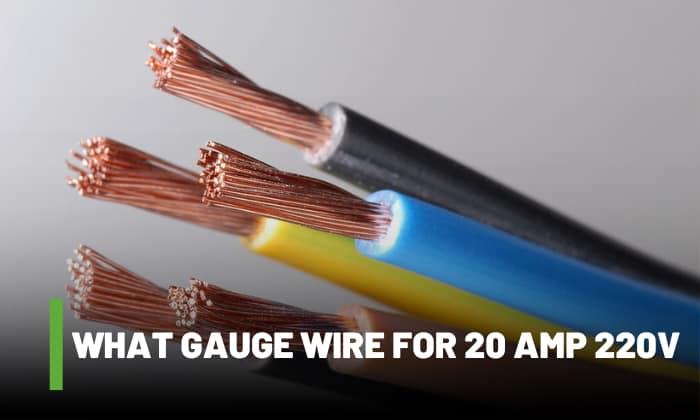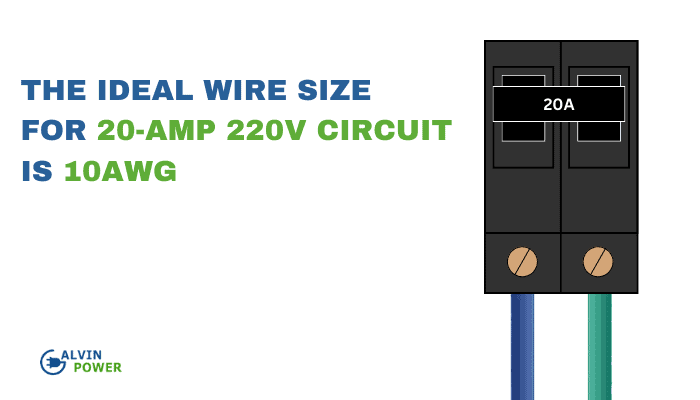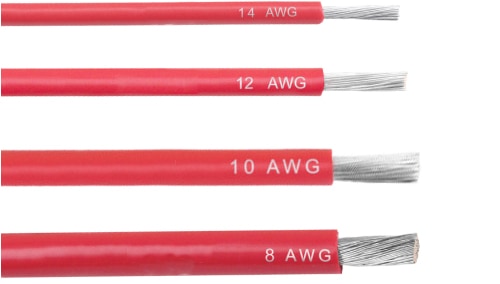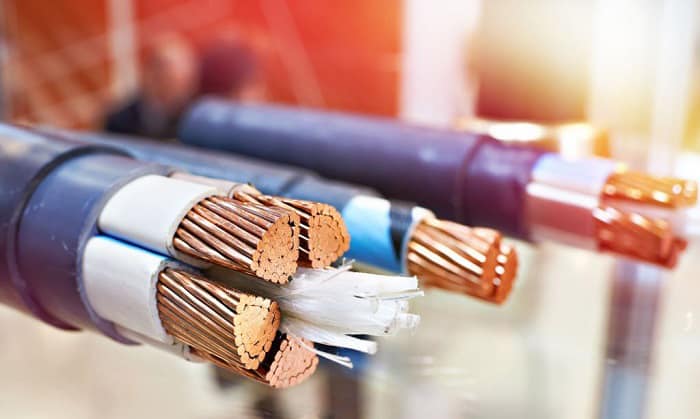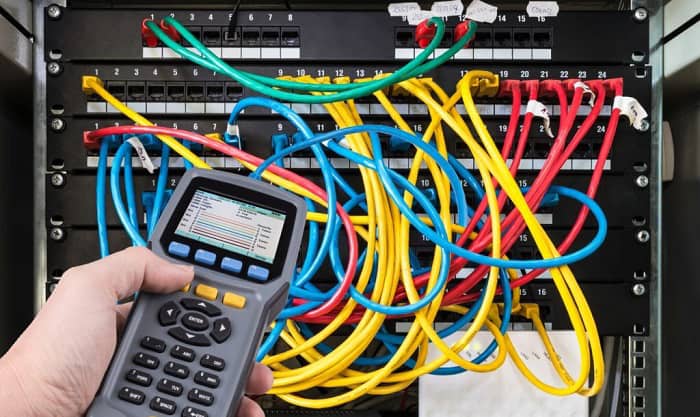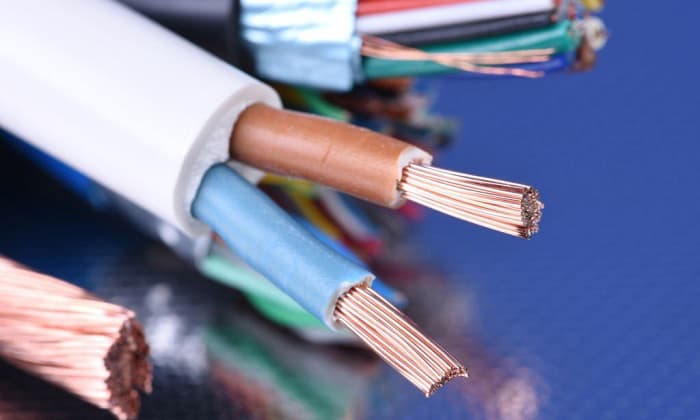Choosing the correct wire gauge is crucial for a circuit’s safe and efficient operation. Now, you’re wondering what gauge wire for 20 amp 220V service is best.
A 10-gauge wire is ideal for a 20-amp 220V circuit. This wire has a 35-amp ampacity, which is more than enough for the setup.
Although a 10-gauge wire is a safe choice, the best option may still differ depending on your property’s electrical wiring diagram. In this post, you’ll learn what gauge wire to use for a 20-amp 220V circuit based on factors like distance.
Table of Contents
What Gauge Wire for 20 Amp Breaker at 220v?
As mentioned previously, a 10-gauge wire can be a safe choice when wiring a 20 amp 220 volt receptacle. However, 12 gauge might be better in certain scenarios when connected to a 20-amp circuit breaker.
Some property owners may not need the extra ampacity provided by the 10-gauge wire. But you still need to calculate your property’s requirements to ensure you’re using the appropriate wire for the service.
Here is a wire gauge chart for quick reference.
| Wire Size | Rated Amperage (For Copper Wires) | Diameter (mm) |
| 14 AWG | 20 | 1.62814 |
| 12 AWG | 25 | 2.05232 |
| 10 AWG | 35 | 2.58826 |
| 8 AWG | 50 | 3.2639 |
14 AWG is not recommended because the wire should only carry 80% of its maximum capacity.
If you’re using a conduit for the connection, ensure that you find out the 20 amp wire size mm. That way, the wire passes through the channel without being at risk of breaking or fraying.
What Wire Gauge for 20 Amp 220 Volt Circuit to Use at Different Distances?
The distance can also play a vital role in selecting the best 20 amp 220 wire size. It’s because voltage drop occurs as the length of the wire used gets longer.
For instance, if the distance from the outlet to the panel is 100 feet or less, you may use a 12-gauge wire for this wiring scenario. Alternatively, you can use an 8-gauge copper 220 volt wire gauge for a 150-foot distance requirement.
Take note that you can use an online calculator to help in determining the correct 20 amp outlet wire gauge based on the distance requirement. Here is a quick summary of the sizes to use for 20 amp 100 feet, 50 feet, and 150 feet.
| Distance | 50 feet | 100 feet | 150 feet |
| Wire size (copper) | 12 AWG | 10 AWG | 8 AWG |
| Wire size (aluminum) | 10 AWG | 8 AWG | 6 AWG |
How to Calculate Gauge Wire?
Another way to find the appropriate wire size to use is through manual calculations. Take note that the formula differs depending on whether you have a single- or three-phase circuit.
1. Single-Phase Circuit Wire Size Formula
\begin{equation}
A(m^2) = \frac{2 \times \rho(\Omega \cdot m) \times L(m) \times I(A)}{V(V)}
\end{equation}
Wherein:
A = cross-sectional area
ρ = conductor resistivity
L = wire length
I = current
V = voltage drop
Bear in mind that the conductor resistivity depends on the wire’s material. The resistive capability of a copper conductor is 1.7241×10-8 Ω·m, while an aluminum variant has 2.6548×10-8 Ω·m.
Using those figures to find the size of a 100-meter, 20-amp 220-volt copper wire with a 6-volt voltage drop, your calculations should look like this:
\begin{equation}
A = \frac{2 \times 1.7241\times10^{-8} \ \Omega\cdot m \times 100 \ m \times 20 \ A}{6 \ V}
\end{equation}
\begin{equation}
A = \frac{0.000068964}{6}
\end{equation}
\begin{equation}
A = 0.000011494 \ m^2
\end{equation}
Multiple this result by 1,000,000 and we get:
\begin{equation}
A = 11.494 \ mm^2
\end{equation}
Compare this result with a wire gauge chart, and you’ll see that the appropriate wire size to use is a 6-gauge model.
2. Three-Phase Circuit Wire Size Formula
The formula to calculate the wire size of a three-phase circuit is slightly different from the one used for a single-phase circuit:
\begin{equation}
A(m^2) = \frac{\sqrt{3} \times \rho(\Omega \cdot m) \times L(m) \times I(A)}{V(V)}
\end{equation}
Using the same example from the previous section, the formula should now look like this:
\begin{equation}
A = \frac{\sqrt{3} \times 1.7241\times10^{-8} \ \Omega\cdot m \times 100 \ m \times 20 \ A}{6 \ V}
\end{equation}
\begin{equation}
A = 9.95 \times 10^{-6} \ m^2
\end{equation}
\begin{equation}
A \times 1{,}000{,}000 = 9.95 \ mm^2
\end{equation}
Rounding up that value, you’ll now know that you need a 7-gauge copper wire for your three-phase 20-amp 220-volt circuit.
You can use these formulas to find the appropriate wire size for your setup, such as for 15 amp 220V circuits. Once you have the result of your calculations, consult the following chart for the appropriate wire to use:
How to Wire a 220-volt, 20-amp Outlet
The plug wiring process for a 220v 20-amp outlet typically demands a double-pole circuit breaker. Also, the neutral wire should connect to the neutral bus.
Here are the items you’ll need for this procedure:
- Double pole 20 amp breaker
- Neutral wire
- 220-volt outlet installation kit
- 12-gauge wire
- Screwdriver
After acquiring the necessary equipment and tools, continue this process by following these steps:
- Connect the hot wires (e.g., black and red wires) to the correct poles in the circuit breaker.
- Connect the neutral wire to the neutral bus in the service panel.
- Attach the green wire to the ground bus in the service panel.
- Secure the connections by tightening their screws.
- Push the wires into the panel box and complete the connection with the outlet.
- Cover the outlet with its accompanying plate.
Bear in mind that you can run two 220v machines off of one 20 amp 240 volt circuit. But make sure that the overall amperage of the two devices doesn’t exceed the breaker’s amp rating.
Tips to Identify a 220v Outlet
Differentiating a 220V outlet from other variants holding various voltage ratings is a reasonably straightforward affair. Here are the signs to watch out for to help you identify a 220v outlet:
- A 220v outlet is usually larger than other models, particularly when compared to a 110v variant.
- 220v outlets typically have three or four slots.
- 220v outlet installation kits generally have two hot wires included in the package.
FAQs
Does A 20 Amp Circuit Require 12 Gauge Wire?
Generally, most 20-amp circuit breakers need at least a 12-gauge copper wire. However, a few exceptions exist, which means you still need to look at your property’s electrical wiring requirements before committing to this type of wire.
Can 10-Gauge Wire Handle 20 Amps?
Yes, a 10-gauge wire can handle up to 35 amps at 75℃. It’s a practical choice for 20 amp outlets or breakers.
What Wire Do I Need For 30 Amp 220v?
You need at least a 10-gauge wire for a 30-amp 220v service. This wire size might be a need for powering appliances like central air conditioners.
What Gauge Wire For 20 Amp 12 Volt?
A 12-gauge wire can be a good choice for a 20 amp 12V setup. This gauge wire has an ampacity of 20 amps and may be used for vehicle batteries.
What Size Wire Is Good For 25 Amp 220v?
A 10-gauge copper wire is a good choice for this setup due to its amperage. It should be sufficient for wiring up to 100 feet wherein the voltage drop won’t be high.
Conclusion
Remember to take the time in thinking about what gauge wire for 20 amp 220v. Take note that using the correct wire size ensures a safe and efficient electrical system for the home.
You may also consult the panel or breaker manufacturer’s instructions if you’re having trouble wiring the connection. Another option is to request help from a certified and reliable electrician to reduce the risks of installation errors significantly.
Related posts you may also like:

I am Edwin Jones, in charge of designing content for Galvinpower. I aspire to use my experiences in marketing to create reliable and necessary information to help our readers. It has been fun to work with Andrew and apply his incredible knowledge to our content.

